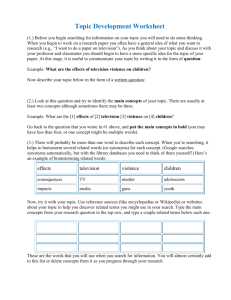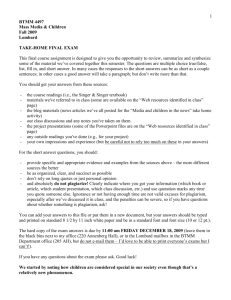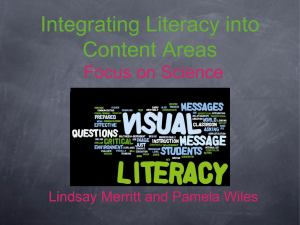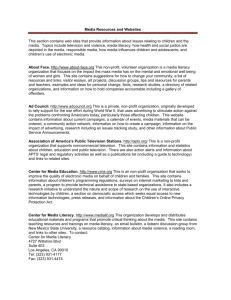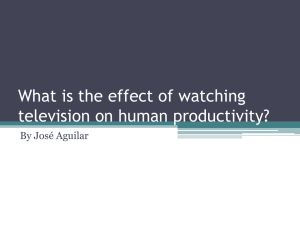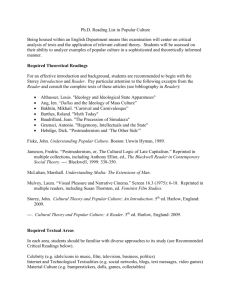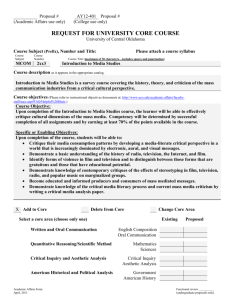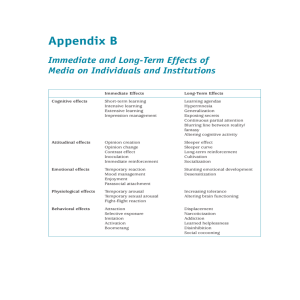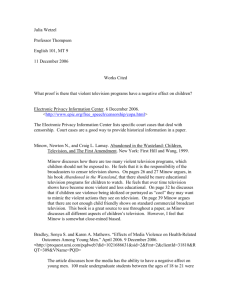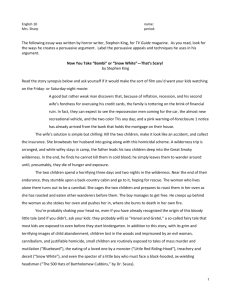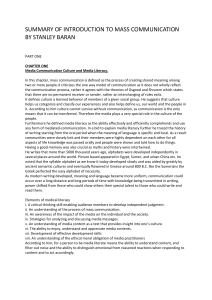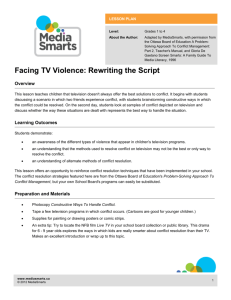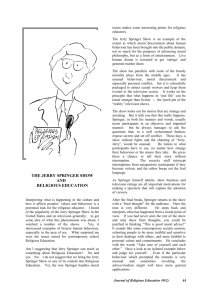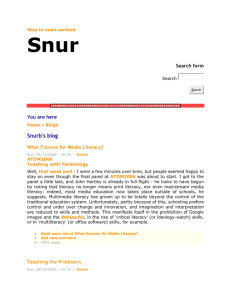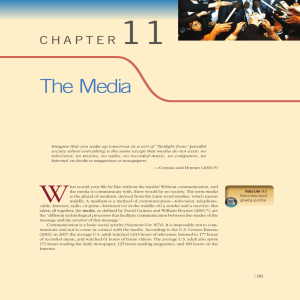Chapter 1 What*s So Special About Literature?
advertisement
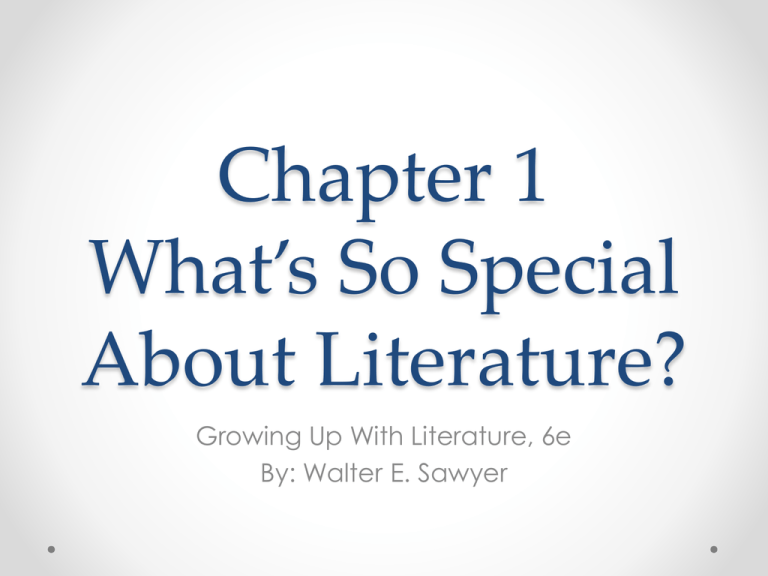
Chapter 1 What’s So Special About Literature? Growing Up With Literature, 6e By: Walter E. Sawyer Definition • “Children’s literature is good quality trade books for children o from birth to adolescence, o covering topics of relevance and interests to children of those ages, o through prose and poetry, fiction and nonfiction.” Content • Topic: o experiences of childhood set in the past, present, or future (e.g., enjoying birthday parties, anticipating adulthood, getting a new pet, enduring siblings, and dealing with family situations); o things that are of interest to children (e.g., dinosaurs, Egyptian mummies, world records) • Manner: o stories are told in a forthright, humorous, or suspenseful manner (stories that are told in nostalgic or overly sentimental terms are inappropriate) Quality “The best children’s books offer readers enjoyment as well as memorable characters and situations and valuable insights into the human condition.” Quality of writing: • originality and importance of ideas • imaginative use of language • beauty of literary and artistic style Values of Literature to Children The Personal Value • • • • • • • enjoyment Imagination and inspiration vicarious experience understanding and empathy cultural heritage moral reasoning literary and artistic preferences Values of Literature to Children The Academic Value • • • • improving reading skills developing writing voice and style learning content-area knowledge promoting art appreciation Current Trends in Children’s Literature • • • • • • Increased numbers of adults reading children’s books, primarily because of the Harry Potter phenomenon. Increasing dominance of illustration in children’s books. Readers are becoming more visually oriented as they spend more time watching television and playing video games and spend less time reading. Fewer full-length novels and more short, high-interest, low-readinglevel novels begins written for 10- to 14-year-olds. Rapid growth of technology in all areas of publishing. As schools adopt computerized management reading programs, reading and books become less a means to enjoyment and discovering new information and more a matter of gaining points. An increase in the publication of bilingual books to accommodate the rapid increase in second language learner students. Increased merchandising of book-related paraphernalia, such as games, craft kits, cookbooks, dolls, and doll accessories. Literature • Adults who work with young children must foster a relationship with literature in their own lives. • A person cannot teach children to love reading and literature without possessing that same love. • Children are perceptive; they can often spot false enthusiasm. An Early Start When children come to school already reading or with a deep interest in reading, certain critical facts can often be found: • They usually had books at home. • They observed adults reading. • They were read to by adults. • They had someone to talk to about books, reading, and literature. Television and Literature Television • The television program is in control. • The presentation proceeds at a predetermined pace • Little or no interaction with the viewer. Book • • • • One can set one’s own pace. The voice can give lines different emotions. The illustrations can be studied, discussed, and touched. Anything in the book can be reread, lingered over, or returned to. o Information transfer can be more effective than with television programs where the information is gone when the program is over. What effect does viewing television violence have on children? Brain research has shown that regular viewing of television violence is related to: • attention problems • aggressive behavior • acceptance of violence as a problem solving tool, and as a regular part of life • unrealistically heightened fear of violence to oneself The Value of Literature • Books can help to inform and explain much about the natural world that children see around them. • Books may be read prior to an experience to prepare children for the new learning. • They may also be read after the experience to clarify misunderstandings, to provide still more information, or to reinforce the learning. • Reading is a springboard to further discussion. • Children can also learn about other cultures through literature. • Young children frequently share the reading with an adult, providing an opportunity to discuss the story and to clarify concerns or questions The Value of Literature (cont.) • Helps children make sense of the world. • Often helps children better able to achieve an accurate understanding of something (example, the beach). • Books enable children to have more meaningful experiences. • Allows time to reflect on experiences, resulting in deeper learning and understanding. • Books keep introducing new and fascinating topics. They encourage children to ask more questions and to seek more answers. Self-Esteem • Through books, children can identify with others like themselves. • They can see how others deal with similar problems. • Children can be encouraged to talk about difficult issues. • Helps children define their feelings and develop a sense of self. • Reading about others who are attempting to make sense of similar situations can bring hope. Tolerance of Others • Literature can help children understand how they fit in and how important it is to relate to others. • Through literature, children can grow up appreciating many different people and cultures. • This leads to the development of empathetic relationships and a reduction in bias. The Human Connection • There is a personal interaction between the child and reader. • The sound and rhythm of language can be slowed down, sped up, made louder, or made to express emotions. • The illustrations and photographs in the book can be touched, studied, discussed, and returned to as the story goes along. Developmentally Appropriate Practices • Knowledge of child development and learning o This knowledge helps adults to develop materials and plan activities that will be healthy, engaging, and challenging to children. • Capabilities and interests of children o This is necessary in order to adapt and respond to individual children. • Cultural environment o Enables adults to develop meaningful learning experiences that are also respectful of the social and cultural environments of the children. What does “reading” really mean? • Reading is the gaining of meaning from a written text. • In this view, children begin the process of learning to read from the moment of birth. • Reading is intertwined with other language modes (i.e., oral language, listening, writing) in such a way that it does not normally exist as a single skill. • Children learn to read by reading, even if an adult does some or most of the reading for them at the initial stages. • The reader brings background experiences to the reading that influences the understanding the reader has of the text. Characteristics of a Holistic Approach A holistic approach assumes that children are developing literacy since the moment of birth, no single approach to literacy is the “right” one, caregivers and parents are important participants in children’s literacy development, and reading is a tool for making sense of the world. A holistic approach is characterized as one which… • Uses whole texts • Uses children’s literature as a key component to literacy development • Shared reading, guided reading, repeated readings, and re-creating stories in play • Is child centered • Values parent involvement Literacy Curriculum Research identifies three key aspects of a literate environment: • Support for the success of the learner. o This means children should have an environment with a variety of printed materials, story times, centers, field trips, and community visitors. • A focus on learning language. o Children must be invited to read and write. Literature sharing is a key tool to be used for this purpose. • Opportunities to explore language. o With an abundance of reading and writing opportunities available, children will be able to develop different strategies for different situations. This will provide them with more opportunities to make language decisions. Reading Skills • Semantics – refers to the meanings that words possess. o Understanding the meanings of words is critical to true reading. • Syntax – refers to the word order • Pragmatics – refers to the practical functions of language. o Things such as tone of voice and the degree of formality. Reading Skills (cont.) Awareness of early literacy skills: o o o o Phonological awareness Alphabet knowledge Print awareness Vocabulary Realistic Expectations • The key problems with the increased use of standardized tests: o First, competency tests can move one’s thinking away from the fact that all children have individual differences. By setting a uniform standard, the tests demand that schools attempt to fit all students into the same mold. o Secondly, the tests tend to force the curriculum downward so that children will be sure to be ready when it is time to take the tests. Younger and younger children, therefore, are presented more and more learning that was previously delayed until they were older. o They discriminate against those from multicultural and lower socioeconomic backgrounds and tend to test only what can be quantified. o Important characteristics such as problem solving and excitement about reading are ignored. o Finally, the tests have encouraged more retentions, failures, developmental kindergartens, and delays of entering schools. Authors and Illustrators • Learning about the personal life and thoughts of an author or illustrator can be a powerful motivation for reading that author’s book. • If resources are available, a day with an author can be a tremendously rewarding experience for children and adults alike. • “Author studies” make students realize they are real people and this is their job. Summary Literature derives its value from three things: • First, it informs and excites children about the world in which they live. • Second, it contributes to developing a positive selfimage and the acceptance of others. • Finally, literature serves to help children connect to both the people sharing a story with them and the people within the story.




